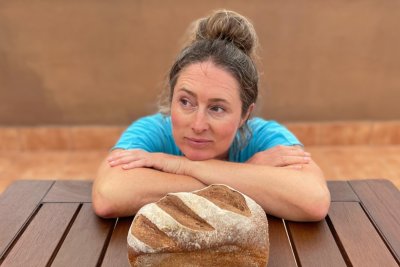Sustain / Real Bread Campaign / Articles
Grain diversity gains
Fermenter, cook, baker and River Cottage tutor Naomi Devlin encourages everyone to give gluten-free grains a go.

For me, bread is life. Even though it’s a hot day and I really shouldn’t add to the heat by turning on the oven, bread is something I cannot do without, so will take the extra few degrees for a slice of the good stuff. I proved the dough in the fridge overnight and now our rental apartment smells like home.
You might ask why I don’t buy bread from a local bakery. It’s because I have coeliac disease and here, in Fuerteventura, good bread made without gluten simply doesn’t exist. You might tell me that good bread made without gluten doesn’t exist anywhere and, for the most part, I’d agree with you. Commercial gluten-free (g-free) products are often an ultra-processed horror show of highly-refined ingredients, additives and other unnecessary extras. Even if it looks and tastes vaguely familiar, I often wonder if a slice of an industrial g-free loaf is any more nourishing than chewing on an old slipper.
For many years I’ve been making my own gluten-free Real Bread and sharing my knowledge with other people. So many grains are inherently gluten free. You might not even have heard of half of them. Would you know what to do with barnyard millet, fonio or riso nerone? Me neither, until I had a go, soaked and fermented them or ground them with my counter-top flour mill. People around the world have recipes for all of these grains, from Ethiopian / Eritrean injera to a host of Indian rotis. Their flavours range from the gentle hay tones of proso millet, to the deep, malty flavour of brown teff. The ability to avoid the free-from aisle, and instead reach for whole grains, is a form of empowerment.
The keys to good g-free
The key to gluten-free bread making is to avoid trying to replicate a wheat flour, sliced white sandwich loaf. Instead, look at what our ancestors were doing with whatever grew around them, as people from other culinary traditions continue to do. When I had a go at these old recipes, I found that people had discovered long ago how to get the most out of those grains, rather than use modified starches, humectants and emulsifiers in an attempt to recreate something produced in a factory.
Ways to make gluten-free grains both delicious and digestible include soaking (either as grain, batter or dough) or roasting or otherwise pre-cooking the grain. In the absence of gluten, you might need to make a roux in order to pre-gelatinise some of the starch, which holds water in the dough and helps to create structure. The result can be tender or crisp. Gluten-free pancakes are lacier, while steamed breads are melt-in-the-mouth tender.
Opportunities for discovery
Sourdough enthusiasts (of which I am one) sometimes say that once you develop a taste for the complexity of naturally-leavened bread, you will never go back to bread made using baker’s yeast, and even less so a loaf of sliced white pap. I could say the same of gluten free whole grains. Rather than seeing a coeliac diagnosis as condemning you to a life without your favourite slice, I focus on it presenting us with opportunities to discover flavours we might not have done otherwise.
These opportunities are not limited to people who must avoid or eliminate gluten, though. For example, you can try adding 10-15% buckwheat flour, toasted first to bring out notes of hazelnut and coffee, to a wheat dough. There isn’t a single, hero-grain that I recommend, rather that you spread the net more widely and be more inclusive when you bake. Our guts crave diversity, whether or not we have digestive or other health conditions. Increasing the range of grains that you eat will almost certainly improve your health in the long term.
The mother of invention
At home in the UK I have a flour mill and access to whatever ingredients I want, with the effect of making me bourgeois in my baking. Because I now spend half my year in Fuerteventura, where supply of everything is variable, I’ve had to become more culinarily-nimble. I clap my hands when cassava flour appears after a month without it.
Making substitutions has been necessary, like using harina P.A.N. (pre-cooked maize flour) or sushi rice, soaked and ground into a paste. On occasion, I have even used grated potato. Because I often find it difficult to maintain a sourdough starter with the varying flours available here, I developed a hybrid bread that uses both lacto-fermentation and a tiny amount of baker’s yeast. Another gift. It’s the bread equivalent of eating seasonally and I often make (re)discoveries that I would not have made had I been able to buy the same old thing every time.
Adversity makes us stronger and diversity makes us more robust. Whether or not you usually eat gluten free, try including some of those unfamiliar grains in your life and see where they take you.
Naomi’s latest book, BREAD: Gluten free, is available now. You can find a Danish style g-free bread recipe from it on the Real Bread Campaign website.
Originally published in True Loaf magazine issue 64, October 2025.
Got something to share?
See YOUR words in print , my baker’s dozen and my favourite bakery.
See also
- Gloriously gluten-free sourdough
- Gluten free intolerance
- Can Real Bread be gluten free?
- Gut instinct
Published Wednesday 1 October 2025
Real Bread Campaign: Finding and sharing ways to make bread better for us, our communities and planet.

